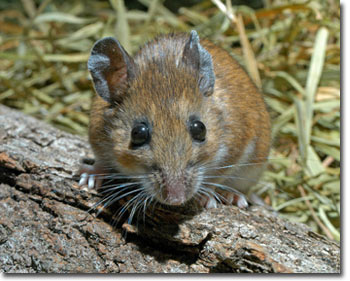If you give a mouse an acorn…
The following is a story, but it describes a real scientific process: the relationship between acorns, mice, ticks and a bacterium.
 On a chilly November night, in a deciduous forest in the eastern U.S., a mouse prepares for the season ahead. More specifically, a female white-footed mouse—competing with other mice and animals for acorns—is reaping the fruits from a mast year: The oak trees in the region produced a generous blanket of acorns across the forest floor this autumn.
On a chilly November night, in a deciduous forest in the eastern U.S., a mouse prepares for the season ahead. More specifically, a female white-footed mouse—competing with other mice and animals for acorns—is reaping the fruits from a mast year: The oak trees in the region produced a generous blanket of acorns across the forest floor this autumn.
The mouse scurries down a tree to gather seeds in the dark—she avoids being spotted by predators since she will not need to travel far to find food. Her nest, a hollowed out nook in an oak tree, holds a hoard of nuts; the pregnant mouse now has a better chance of keeping herself and her upcoming litter alive. With the abundance of food, she may even be more likely to mate again during the winter.
Mama mouse and her pups are not the only creatures populating this forest. Squirrels, chipmunks, raccoons, birds and deer will likely take advantage of the autumn acorn harvest as well. The forest will be rustling, chirping and snapping with life, especially in the spring when other creatures emerge from hibernation or become more active in the warmer weather. One such species, tucked within leaf litter on the forest floor, is Ixodes scapularis, commonly known as the deer or black-legged tick.
In the spring and summer, nymphs of the black-legged tick search for hosts. Some of them are carrying the bacterium Borrelia burgdorferi from feeding on infected mice, chipmunks and other small animals a year earlier. Throughout their lifecycle, the ticks feed on small rodents, birds, opossums and even humans who come in contact with them. If the tick is carrying B. burgdorferi, it can transmit the pathogen to these animals as well—in humans, this can lead to Lyme disease.
Mama mouse does not groom herself as frequently as, say, a nearby opossum, and so she does not remove all of the ticks that take hold. She also does not have the immunity like some of her larger forest companions, making her more susceptible to infection from the nymphs. Once infected, she can serve as a sort of reservoir for transmitting the bacteria to other black-legged ticks well into the summer and fall. And infection would not limit her mating and other physical activities.
Due to the mast of acorns from the previous autumn, other mice will survive the winter as well—providing black-legged ticks with an abundance of potential hosts. Many of these mice could be infected with B. burgdorferi.
But there is one unsuspecting animal that could lower the risk of transmission for this bacterium. Despite the commonly used name, deer ticks—also called black-legged ticks—do not pose the same risks to deer as they do to humans and other animals. That is, deer are actually immune to the bacterium.
So ticks that feed on deer will not acquire the bacterium, causing a dead end for B. burgdorferi. The greater the biodiversity of the forest, the more likely the ticks will feed on deer and other animals like opossums that are not typically carriers of the bacterium. But for now, the pregnant mouse sleeps with her gathered acorns, unaware of B. burgdorferi or even bacteria for that matter. She is prepared for the winter ahead.
This is just one well-studied example of biodiversity affecting the spread of pathogens.
Read more in the recent Nature News article “More species means less disease” describing research by Felicia Keesing, Bard College in Annandale, New York, and colleagues.